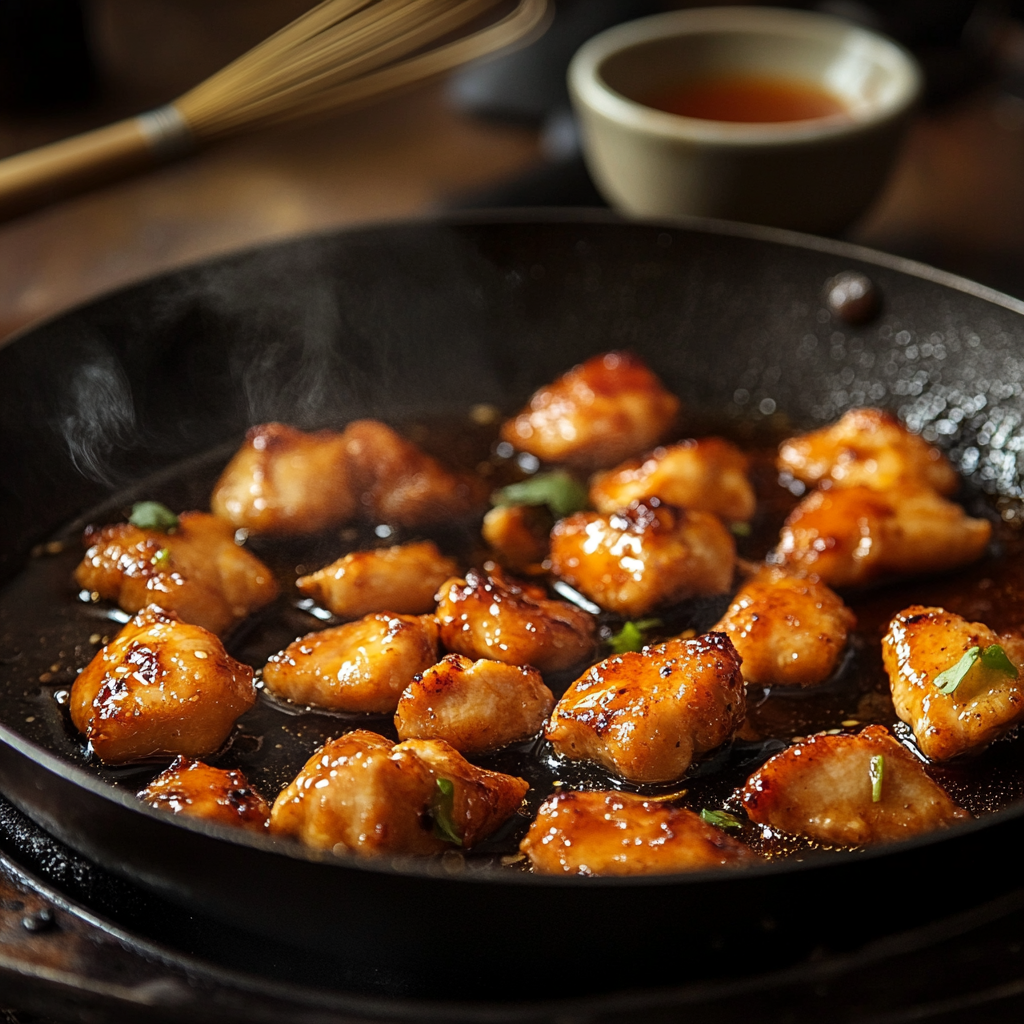Introduction
Chicken Nanban is more than just a Japanese dish; it’s a harmonious blend of tangy, sweet, and savory flavors that tell a story of cultural fusion. Originating in Miyazaki Prefecture, this dish has become a symbol of Japanese comfort food with a touch of sophistication. From its intriguing history to the details of its preparation, this guide explores every aspect of Chicken Nanban, ensuring you’ll gain a deep appreciation for its unique appeal.
Table of contents
- Introduction
- What is Chicken Nanban?
- Historical Background
- Ingredients and Preparation
- Cultural Significance
- Nutritional Information
- Cooking at Home
- Serving Suggestions
- Side Dishes and Pairings
- Beverage Pairings
- Frequently Asked Questions (FAQs)
- What does ‘Nanban’ mean in Chicken Nanban?
- How is Chicken Nanban different from Karaage?
- What is Japanese Nanban?
- What is the difference between Chicken Nanban and karaage?
- What is the difference between Chicken Katsu and Chicken Nanban?
- Why is it called Chicken Nanban?
- Conclusion
What is Chicken Nanban?
Chicken Nanban is a celebrated dish in Japan that marries crisp, golden-fried chicken with a rich, tangy Nanban sauce and creamy tartar topping. It’s a delightful combination that’s satisfying in every bite. While it might look like a simple fried chicken dish, its roots and flavors are steeped in history and technique.
How Chicken Nanban Differs from Other Japanese Fried Chicken
You might wonder, “How is Chicken Nanban different from Karaage?” Well, while both dishes involve fried chicken, Chicken Nanban stands out with its unique vinegar-based Nanban sauce. This sauce gives the dish a sweet and sour kick that elevates its flavor profile. Additionally, the dish is traditionally served with tartar sauce, which adds a creamy, indulgent touch.
Why is Chicken Nanban So Popular?
Its popularity lies in its versatility. Whether served as a main course, a bento staple, or a dish for special occasions, Chicken Nanban appeals to everyone. The balance of textures—crispy chicken with smooth tartar—and flavors make it a beloved meal across Japan and beyond.
Historical Background
Origins of the Dish
The story of this culinary gem begins in Miyazaki Prefecture, a southern region of Japan known for its inventive approach to food. During the mid-20th century, local chefs created a dish that merged traditional Japanese flavors with techniques inspired by Portuguese cuisine, introduced to Japan during the Nanban trade era.
Portuguese traders brought deep-frying techniques and ingredients like vinegar, which significantly influenced the development of this recipe. The chefs of Miyazaki adapted these methods to suit Japanese tastes, creating a dish that is both flavorful and distinctly regional. Today, this fried chicken specialty is a symbol of culinary innovation, celebrated for its unique balance of sweet, tangy, and savory notes.
Etymology of ‘Nanban’
The term “Nanban” is steeped in history. In ancient Japan, it referred to “Southern Barbarians,” a term used to describe Portuguese and Spanish merchants who arrived by sea. Over time, “Nanban” became associated with foreign goods and influences, including culinary traditions.
When applied to this dish, the name reflects its cross-cultural origins. The vinegar-based glaze, known as Nanban sauce, embodies this blend of local and Western techniques, offering a perfect example of how different cultures can merge to create something extraordinary.
Ingredients and Preparation
Key Ingredients
The heart of Chicken Nanban lies in its carefully chosen ingredients, each playing a vital role in creating its signature flavor. The main components include:
- Chicken (thighs or breast): Provides the tender and juicy base for the dish.
- Flour and Eggs: Essential for coating the chicken and achieving a crispy, golden crust when fried.
- Soy Sauce and Rice Vinegar: The foundation of the Nanban sauce, offering a balance of umami and tangy flavors.
- Sugar: Adds a hint of sweetness to offset the acidity of the vinegar.
- Tartar Sauce Ingredients (mayonnaise, boiled eggs, pickles): The creamy topping that enhances the richness of the dish.

Traditional Preparation Methods
Making Chicken Nanban involves a few steps that require care but are not overly complicated. Here’s how it’s traditionally prepared:
- Prepare the Chicken: Cut the chicken into bite-sized pieces and season with salt and pepper.
- Coat and Fry: Dredge the chicken in flour, dip it into a beaten egg mixture, and fry until it turns a crispy golden brown.
- Create the Nanban Sauce: Combine soy sauce, rice vinegar, sugar, and a touch of water in a saucepan. Heat until the sugar dissolves, creating a tangy-sweet glaze.
- Marinate the Fried Chicken: Dip the freshly fried chicken into the warm Nanban sauce, allowing it to absorb the flavors.
- Top with Tartar Sauce: Once plated, spoon a generous amount of tartar sauce over the chicken for a creamy finish.

This step-by-step process ensures that each piece of chicken is crispy, flavorful, and perfectly complemented by the sauce and topping.
Variations of Chicken Nanban
Over time, Chicken Nanban has seen several adaptations, reflecting both regional creativity and modern culinary trends.
- Miyazaki Style: The classic version, featuring a balance of sweet and sour Nanban sauce and rich tartar.
- Kyushu Variation: Some regions of Kyushu add a touch of citrus, such as yuzu, to brighten the sauce.
- Health-Conscious Twist: Baked or air-fried versions are gaining popularity among those seeking a lighter option.
- Fusion Styles: In global kitchens, chefs experiment with adding spices, swapping chicken for fish, or even incorporating local ingredients into the sauce.
Each variation keeps the essence of Chicken Nanban while catering to diverse palates, ensuring its place as a beloved dish worldwide.
Cultural Significance
A Staple in Japanese Cuisine
This iconic dish has become a cherished part of Japan’s culinary heritage. Known for its bold flavors and satisfying textures, it frequently appears in bento boxes, paired with rice, pickles, and miso soup. It’s also a popular choice for family gatherings and celebrations, where its universal appeal brings people together.
What sets this fried chicken specialty apart is its ability to combine comfort and sophistication. While similar dishes might focus solely on crispiness, this recipe elevates the experience with its tangy glaze and creamy topping, ensuring it remains a beloved option for many.
A Global Culinary Favorite
As Japanese cuisine continues to thrive on the global stage, this fried chicken dish has gained popularity beyond its homeland. It has become a star feature on menus in Japanese restaurants worldwide, often appreciated for its unique combination of flavors.
Chefs and food enthusiasts outside Japan have also embraced this recipe as a base for creativity. By incorporating local ingredients or reimagining the sauce, they’ve turned this classic into an adaptable culinary masterpiece. Its international appeal showcases the remarkable versatility of this fusion dish, solidifying its status as a favorite among diverse audiences.
Nutritional Information
Nutritional Profile of Chicken Nanban
Chicken Nanban is undeniably delicious, but what about its nutritional value? The dish is a combination of fried chicken, tangy sauce, and creamy tartar, making it a calorie-dense yet satisfying meal. On average, a single serving of Chicken Nanban provides approximately:
- Calories: 400–500 kcal, depending on portion size and preparation.
- Protein: 25–30 grams, primarily from the chicken.
- Carbohydrates: 15–20 grams, contributed by the sauce and flour coating.
- Fat: 20–25 grams, largely from frying and the tartar sauce.
This dish is rich in protein, making it an excellent option for muscle repair and growth. The tartar sauce, containing eggs and mayonnaise, provides healthy fats, while the vinegar in the Nanban sauce adds a touch of acidity that may aid digestion.
Nutritional Profile of Chicken Nanban (Per 100g)
Chicken Nanban offers a delicious balance of flavors, but its nutritional content is also worth considering. Here’s the approximate nutritional breakdown per 100 grams of the dish:
| Nutrient | Amount per 100g |
|---|---|
| Calories | 210 kcal |
| Protein | 12 g |
| Carbohydrates | 10 g |
| Fat | 14 g |
| Saturated Fat | 3 g |
| Sodium | 380 mg |
| Fiber | 0.5 g |
| Sugar | 3 g |
Health Considerations
While Chicken Nanban is a flavorful indulgence, it’s worth noting a few health considerations. The frying process contributes to higher fat content, so moderation is key. Opting for a baked or air-fried version can significantly reduce calories and fat without compromising on taste.
For those watching their sodium intake, it’s advisable to use low-sodium soy sauce and adjust the seasoning in the tartar sauce. Adding fresh vegetables or serving it with a side salad can further enhance its nutritional balance.
With mindful preparation, Chicken Nanban can be enjoyed as part of a balanced diet, offering both taste and nourishment.
Cooking at Home
Homemade Chicken Nanban Recipe
Preparing Chicken Nanban at home is easier than you might think. First, gather all the necessary ingredients to ensure a smooth cooking process. Then, follow these simple steps to recreate this iconic Japanese dish:
Ingredients:
- 2 boneless chicken thighs or breasts
- 2 eggs (beaten)
- ½ cup all-purpose flour
- Oil for frying
- Nanban Sauce:
- 3 tbsp soy sauce
- 3 tbsp rice vinegar
- 2 tbsp sugar
- 2 tbsp water
- Tartar Sauce:
- ½ cup mayonnaise
- 1 boiled egg (chopped)
- 1 tbsp pickles (finely chopped)
- 1 tsp lemon juice
Instructions:
- Prepare the Chicken: Start by cutting the chicken into bite-sized pieces. Next, season with salt and pepper to taste.
- Coat the Chicken: After seasoning, dredge the chicken in flour. Then, dip it into the beaten eggs for an even coating.
- Fry the Chicken: Heat oil in a pan over medium heat. Once hot, carefully fry the chicken until it’s golden brown and fully cooked, approximately 5–7 minutes per side.
- Make the Nanban Sauce: Meanwhile, combine soy sauce, rice vinegar, sugar, and water in a small saucepan. Stir and heat until the sugar dissolves.
- Marinate the Chicken: As soon as the chicken is fried, dip each piece into the warm Nanban sauce to coat it thoroughly.
- Prepare the Tartar Sauce: Finally, mix mayonnaise, boiled egg, pickles, and lemon juice in a small bowl. Adjust the seasoning as needed.
- Serve: Plate the chicken, drizzle the tartar sauce generously on top, and enjoy it with a side of rice and vegetables.
Common Mistakes to Avoid
Although making this dish is straightforward, a few common mistakes can affect the final outcome. For example, frying the chicken at too high a temperature might result in a burnt coating and undercooked meat. Therefore, maintaining medium heat is crucial for even cooking.
Additionally, skipping the sauce marination step can make the dish less flavorful. Remember, the Nanban sauce is essential for infusing the chicken with its signature tangy taste. Finally, balancing the tartar sauce ingredients—particularly the pickles and mayonnaise—ensures the topping complements rather than overwhelms the dish.
Serving Suggestions
Side Dishes and Pairings
When it comes to enhancing the flavors of Chicken Nanban, side dishes play a crucial role. For instance, steamed rice is a classic accompaniment that balances the bold and tangy taste of the dish. Similarly, miso soup adds warmth and umami, creating a well-rounded meal. In addition, pickled vegetables like tsukemono provide a refreshing crunch, while shredded cabbage offers a light, crisp contrast to the richness of the chicken.
Moreover, modern twists on side dishes are becoming increasingly popular. For example, roasted sweet potatoes or cucumber salad can bring new dimensions of flavor to the meal. Regardless of the pairing, the key is to create a harmonious balance of textures and tastes that complement the main dish.
Beverage Pairings
Choosing the right beverage can elevate your Chicken Nanban experience even further. For non-alcoholic options, Japanese teas like sencha or barley tea are traditional favorites. Alternatively, sparkling water with a slice of citrus works wonderfully to cleanse the palate between bites. In many cases, a light ginger-based drink can also enhance the dish’s tangy notes.
Ultimately, the goal is to find pairings that complement the dish’s vibrant flavors without overpowering them. As a result, every bite and sip becomes part of a satisfying and cohesive dining experience.
Frequently Asked Questions (FAQs)
What does ‘Nanban’ mean in Chicken Nanban?
The term “Nanban” historically refers to “Southern Barbarians,” a name given to early Portuguese and Spanish traders who arrived in Japan. This reflects the foreign culinary influence that eventually shaped the dish into what it is today.
How is Chicken Nanban different from Karaage?
Although both are fried chicken dishes, their preparation and flavors set them apart. Chicken Nanban is first marinated in a tangy Nanban sauce, then served with creamy tartar sauce for added richness. In contrast, karaage focuses on crispy fried chicken marinated in a savory soy-ginger blend. Therefore, Chicken Nanban offers a sweet and tangy profile, while karaage delivers a straightforward and savory experience.
What is Japanese Nanban?
Japanese Nanban refers to a unique style of cooking inspired by Western or foreign influences, particularly from the Portuguese and Spanish during the 16th century. The word “nanban” historically translates to “southern barbarian,” a term used to describe European visitors. In culinary terms, Nanban dishes are characterized by their tangy, sweet, and sour flavors achieved through marinades or sauces made with vinegar, soy sauce, and sugar. Notably, this style is prominently featured in recipes like Chicken Nanban.
What is the difference between Chicken Nanban and karaage?
While both Chicken Nanban and karaage are beloved Japanese fried chicken dishes, their differences lie in their preparation and taste. Karaage involves marinating chicken in a mixture of soy sauce, ginger, and garlic, then coating it in flour or potato starch before deep-frying it to a crispy perfection. On the other hand, Chicken Nanban is fried chicken coated in a tangy Nanban sauce and topped with tartar sauce, which provides a rich and creamy contrast. Consequently, karaage is more savory, while Chicken Nanban has a sweet and tangy flair.
What is the difference between Chicken Katsu and Chicken Nanban?
Chicken Katsu and Chicken Nanban differ in their breading, preparation, and flavor profiles. Chicken Katsu is a breaded and deep-fried cutlet coated in panko breadcrumbs, resulting in a light and crispy texture. It is usually served with a thick, tangy katsu sauce and shredded cabbage. Meanwhile, Chicken Nanban is made by frying chicken pieces, coating them in a sweet and sour Nanban sauce, and serving them with tartar sauce. As a result, Chicken Katsu emphasizes crispy texture and umami flavors, whereas Chicken Nanban combines sweet, sour, and creamy notes for a more layered taste.
Why is it called Chicken Nanban?
The name “Chicken Nanban” reflects its historical and cultural origins. During the Sengoku and Edo periods in Japan, the term “Nanban” was used to describe foreign influences, especially those introduced by Portuguese and Spanish traders. The dish’s sweet and sour flavor profile, which incorporates ingredients like vinegar and sugar, was directly influenced by these Western cuisines. Over time, “Nanban” came to represent dishes with a distinct Western twist, and Chicken Nanban carries on this legacy with its signature tangy sauce and tartar topping.
Conclusion
The Enduring Appeal of Chicken Nanban
Undoubtedly, Chicken Nanban has earned its place as a timeless culinary treasure. Not only does it showcase the creativity of Japanese cuisine, but it also bridges cultural influences in a way that feels seamless. While many dishes rely on simplicity, this one shines through its complex balance of textures and flavors.
Furthermore, its versatility makes it suitable for various occasions. Whether you’re enjoying it as a comforting homemade meal or indulging in it at a restaurant, this dish never fails to deliver satisfaction. Additionally, its adaptability to modern tastes ensures that it remains relevant and cherished by food lovers everywhere.
So, why wait? By trying out this dish at home, you can experience its delightful combination of crispy fried chicken, tangy sauce, and creamy tartar firsthand. After all, there’s no better way to appreciate its unique charm than by creating it yourself.

